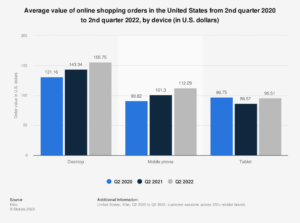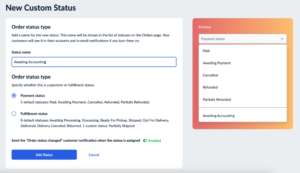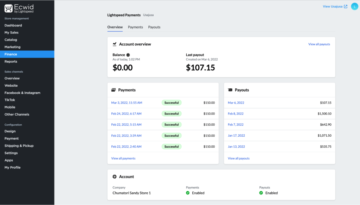
Can you believe how much can be packed into a barcode?
In this episode of the Ecwid Ecommerce Show, we meet with Shane Morris and Megan Baumer from GS1 US.
GS1 US is the official issuer and administrator of the UPC barcode, which is the cornerstone of the global supply chain.
Listen to our podcast to learn more about barcodes and the differences between product identifiers such as UPC and GTIN. You’ll learn how these identifiers help with inventory management and contribute to expanding your online business.
Understanding barcodes
The Universal Product Code, or UPC, is a barcode symbology used worldwide to track trade items in stores.
A Global Trade Item Number, or GTIN, is the number below a barcode. The GTIN uniquely identifies a product when scanned at the checkout counter or added to a shopping cart online.
GTINs and UPCs are often used interchangeably, but they are different. The UPC is the barcode that carries and identifies the Global Trade Item Number.
GS1 is a not-for-profit supply chain standards organization that issues GTINs and UPCs. They develop and maintain the world’s most widely used supply chain standards.
Key benefits of GTIN for online sellers
GTIN bridges the gap between the physical and digital worlds. They can be used to boost search engine optimization, prove a brand’s authenticity online, and be used to create unified analytics across multiple channels.
Search engines, marketplaces, shopping engines, and retailers rely on GTINs. These platforms use GTINs to organize the billions of products they host, helping to accurately identify and return the correct information to a potential customer searching for a specific item. For example, if a person puts a GTIN into Google, Google should return either a web page or an image that provides access to the searched item.
Shane Morris highlights four key benefits in the ecommerce space where the GTIN serves a purpose:
Improved SEO
A request for a GTIN or UPC from a marketplace or Google might be the first place a new business will encounter GS1 standards. Assigning GTINs to your products when listing on Google Shopping or your website can significantly improve search results, impressions, and conversions.
Google has actually been advocating for brands to associate a GTIN with their product listing in order to optimize searchability.
Better logistics process
You will likely need to use third-party logistics providers as you expand your business to get help with managing the supply chain. That can include warehouse management, order fulfillment, and shipping orders.
These partners will want a way to identify your product. A barcode in particular will help them organize their stock and supply.
If you don’t provide a barcode, they’ll use the identifier they assign in their internal system and give it to you. As your business and product range grow, different warehouses assigning your product with different identifiers will get exponentially confusing.
But when you provide third-party logistics providers with GTINs, they can just scan your UPC barcodes. This way, you only need to manage your inventory using the identifiers you personally assign to your products, preventing disorganization.
Verifying a business on online marketplaces
Marketplaces want to ensure that their customers will only interact with legitimate brands selling legitimate products. There are standards in place to ensure that legitimacy—one of these is the GTIN.
Brands must license GTINs, preferably from GS1, and associate their products with these numbers. When a brand does this, its product will be linked back to its company and can be verified.
Essential for omnichannel strategy
Most businesses want to be everywhere their customers are. There are many marketplaces and stores, both offline and online, where you can sell your products.
Having a GS1 GTIN for your products will open up countless doors to the numerous retailers and marketplaces that require them.
Getting GTINs for your products
To get GTINs for your products, visit the GS1 US website or the GS1 global website if you are a non-US brand.
Also, check out the following resources that Shane and Megan mention in the episode:
Assigning GTINs to your products can only help your business succeed. Listen to the podcast to learn even more!
- SEO Powered Content & PR Distribution. Get Amplified Today.
- Platoblockchain. Web3 Metaverse Intelligence. Knowledge Amplified. Access Here.
- Source: https://www.ecwid.com/blog/podcast-with-gs1-us-more-than-just-a-barcode.html
- a
- About
- access
- accurately
- across
- actually
- added
- advocating
- analytics
- Associate
- authenticity
- back
- believe
- below
- benefits
- between
- billions
- boost
- brand
- brands
- bridges
- business
- businesses
- chain
- channels
- check
- Checkout
- code
- company
- confusing
- contribute
- conversions
- Counter
- create
- customer
- Customers
- develop
- differences
- different
- digital
- digital worlds
- Dont
- doors
- ecommerce
- either
- Engine
- Engines
- ensure
- Ether (ETH)
- Even
- example
- Expand
- expanding
- exponentially
- First
- following
- from
- gap
- get
- Give
- Global
- global trade
- Grow
- help
- helping
- highlights
- host
- How
- HTML
- HTTPS
- identifier
- identifies
- identify
- image
- improve
- include
- information
- interact
- internal
- inventory
- Inventory Management
- Issuer
- issues
- items
- Key
- LEARN
- License
- likely
- linked
- listing
- logistics
- maintain
- manage
- management
- managing
- many
- marketplace
- marketplaces
- Meet
- might
- more
- most
- multiple
- Need
- New
- number
- numbers
- numerous
- official
- offline
- omnichannel
- online
- open
- optimization
- Optimize
- order
- orders
- organization
- packed
- particular
- partners
- person
- Personally
- physical
- Place
- Platforms
- plato
- Plato Data Intelligence
- PlatoData
- podcast
- potential
- preventing
- Product
- Products
- Prove
- provide
- providers
- provides
- purpose
- Puts
- range
- request
- require
- Resources
- Results
- retailers
- return
- scan
- Search
- search engine
- searching
- sell
- Selling
- serves
- Shipping
- Shopping
- should
- show
- significantly
- Space
- specific
- standards
- stock
- stores
- succeed
- such
- supply
- supply chain
- system
- The
- their
- track
- trade
- Universal
- us
- use
- verified
- web
- Website
- which
- widely
- will
- world’s
- worldwide
- Your
- zephyrnet












